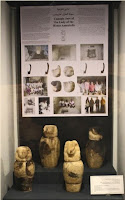The Neith of Spetses
Anargyros was also fascinated with Egyptology, and in 1903 he began construction of a grand mansion decorated inside and out with Egyptian décor. Finished in 1904, Anargyros named it “Neith” after the Egyptian goddess of war and hunting. It immediately became the most imposing building in Spetses, hosting kings, queens, and other dignitaries of that time. These guests entered past one of the mansion’s most impressive features, the two large sphinxes flanking the entrance.
Two 4,500-Year-Old Homes Found Near Giza Pyramids
Credit: Copyright 2016 by Ancient Egypt Research Associates
Archaeologists have discovered two ancient homes near the Giza pyramids in Egypt. The structures may have housed officials responsible for overseeing the production of food for a paramilitary force more than 4,500 years ago.
4,000-year-old Egyptian 'Lost City of the Dead' FOUND: 800 tombs unearthed at burial site
MINISTRY OF ANTIQUES
The site, near Al Ayyat, on the edge of the Sahara Desert had previously been left alone for about 4,000 years, until now.
Egyptologists believe it is one of the largest necropolis (city of the dead) dating back to the Middle Kingdom period of Egyptian history.
Inside the crypts there is enough space that experts believe it could have held thousands of corpses.
For another article see, Ancient Egypt: 800 Tombs Discovered In Massive Grave Site Lurking Between Two Pyramids
The Mummy Returns
PHOTO BY ROBERT ISENBERG
Everybody loves Nesmin. The RISD Museum staff all refer to Nesmin by name. They encourage visitors to see Nesmin, to spend a little time with him on the third floor. Nesmin is much beloved, especially for a guy who died 2,250 years ago.
The Ptolemaic mummy has been on display since 1938, a well-wrapped bundle of cloth covered in intricate painting. Yet after much discussion, the museum has decided to put Nesmin back in his ornate coffin, where he was originally ensconced in the third century B.C.E.
The Latest Discoveries in Egyptology (July-August 2018)
A Saite-Persian Period gilded mummy mask found at Saqqara (Photo: AP Photo/Amr Nabil)
Every few months, the Nile Scribes bring you summaries of the latest news and discoveries in Egyptology, both from the field and the lab. We’ll introduce you to the newest archaeological finds or recently undusted manuscripts being rediscovered in museum collections, plus other new theories stirring in the Egyptological Zeitgeist. This summer has seen a wealth of new discoveries and research, with much excitement generated by the discovery of an intact, black sarcophagus in Alexandria. Another intriguing find was the identification of the world’s oldest cheese from the tomb of an Egyptian official at Saqqara.
Eye Of Horus: Meaning Behind The Egyptian Eye
The fractions of the Eye of Horus. Image source: Wikipedia.
The Eye of Horus, also called the Egyptian Eye, the Wedjat, or the all-seeing eye, was a powerful symbol for the ancient Egyptians. The Eye was widely used in funeral rites and as protective amulets in ancient Egypt. Often made of gold, wood, carnelian, or lapis, the Eye of Horus was often worn as jewelry worn by both the living and the dead or as an amulet to be tucked between the folds of linen wrapped around mummified corpses.
Ankh Meaning: The Egyptian Cross Symbol
Image source: Wikipedia
This is an ancient symbol that originated in Egypt where it was used in portraits of gods, usually seen carried on each hand, on their chest or carried by the cross’s loop. The ankh is seen in the Egyptian pantheon either in close proximity or in the hand of most Pharaohs and deities.
But this symbol is also found among other ancient cultures outside Europe, most notably in Persia (present-day Iran), and Mesopotamia (present-day Iraq). It is also found on the seal of King Hezekiah in the bible.
Breathtaking Ancient Egyptian tombs dating back to the Sixth Dynasty are reopened to the public for the first time since they were discovered nearly 80 years ago
The tombs of Mehu have been reopened to the viewing public for the first time in almost 80 years since it was discovered in 1940 in Giza, Egypt.
Mehu's tombs, which are situated in the vast ancient burial ground of Saqqara, are deemed to be the most beautiful tombs at the site.
The magnificent burial site was restored by the Egyptian Ministry of Antiques, who reinstated the tomb paintings pictured on the walls of the chambers.
Meeting the “Queens of Egypt” in Montréal
The exhibition space imagining the royal harem beside the river Nile (photo: Nile Scribes)
Having opened in early April at Pointe-à-Callière in Montréal, Canada, the new exhibition Reines d’Égypte (Queens of Egypt) invites visitors on a tour of the east and west banks of the Nile during the New Kingdom. The Nile Scribes were able to visit Pointe-à-Callière this summer and see this special exhibition for ourselves. Including objects from temple, palace, and harem contexts on the east bank, the exhibition also featured objects associated with preparing for the afterlife on the west bank.
Papiro di Aaner video
Papyrus of Aaner, priest of the goddess Mut, Third Intermediate Period (1076 – 722 a.C.) Click this link to watch the video.
































